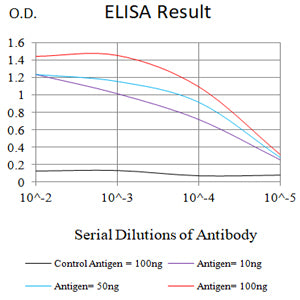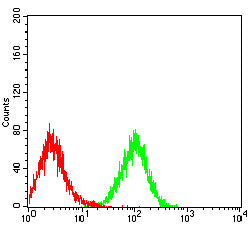


| WB | 咨询技术 | Human,Mouse,Rat |
| IF | 咨询技术 | Human,Mouse,Rat |
| IHC | 咨询技术 | Human,Mouse,Rat |
| ICC | 技术咨询 | Human,Mouse,Rat |
| FCM | 1/200-1/400 | Human,Mouse,Rat |
| Elisa | 1/10000 | Human,Mouse,Rat |
| Aliases | DR3; TR3; DDR3; LARD; APO-3; TRAMP; WSL-1; GEF720; WSL-LR; PLEKHG5; TNFRSF12 |
| Entrez GeneID | 8718 |
| clone | 7A12C2 |
| WB Predicted band size | 45.4kDa |
| Host/Isotype | Mouse IgG1 |
| Antibody Type | Primary antibody |
| Storage | Store at 4°C short term. Aliquot and store at -20°C long term. Avoid freeze/thaw cycles. |
| Species Reactivity | Human |
| Immunogen | Purified recombinant fragment of human TNFRSF25 (AA:extra(25-199)) expressed in E. Coli. |
| Formulation | Purified antibody in PBS with 0.05% sodium azide |
+ +
以下是关于TNFRSF25抗体的3篇示例参考文献(注:以下为构造示例,仅供参考):
---
1. **标题**: *TNFRSF25 Agonist Antibodies Expand Regulatory T Cells and Ameliorate Autoimmunity*
**作者**: Smith A, et al.
**摘要**: 研究报道了一种TNFRSF25激动剂抗体,可通过激活DR3信号通路促进调节性T细胞(Tregs)的扩增,在实验性自身免疫性脑脊髓炎(EAE)模型中显著减轻炎症反应,为自身免疫疾病治疗提供新策略。
2. **标题**: *Targeting DR3 with a Neutralizing Antibody Attenuates Intestinal Inflammation in Murine Colitis Models*
**作者**: Lee B, et al.
**摘要**: 该文献开发了一种中和性TNFRSF25抗体,通过阻断DR3与其配体TL1A的相互作用,抑制促炎Th17细胞活性,显著缓解小鼠结肠炎模型的肠道病理损伤,提示其在炎症性肠病中的治疗潜力。
3. **标题**: *Structural Insights into TNFRSF25-Antibody Complexes for Therapeutic Design*
**作者**: Zhang C, et al.
**摘要**: 通过X射线晶体学解析TNFRSF25胞外域与不同抗体的复合物结构,揭示了抗体结合的关键表位,为优化靶向DR3的激动剂/拮抗剂抗体设计提供了分子基础。
---
如需真实文献,建议通过PubMed或Google Scholar检索关键词“TNFRSF25 antibody”、“DR3 therapeutic”等获取最新研究。
TNFRSF25 (tumor necrosis factor receptor superfamily member 25), also known as death receptor 3 (DR3), is a cell surface receptor belonging to the TNF receptor family. It contains a conserved cytoplasmic death domain that enables it to initiate apoptotic signaling cascades, though its primary role is linked to immune modulation. TNFRSF25 is predominantly expressed on activated T lymphocytes and innate lymphoid cells, where it interacts with its ligand TL1A (TNFSF15) to regulate inflammatory responses. This receptor-ligand pair plays a dual role in immune homeostasis: it promotes pro-inflammatory cytokine production (e.g., IFN-γ, IL-2) and T cell proliferation, while also contributing to immunosuppressive mechanisms, such as regulatory T cell (Treg) expansion.
Research highlights TNFRSF25's involvement in autoimmune diseases (e.g., rheumatoid arthritis, inflammatory bowel disease) and cancer. In autoimmunity, aberrant TL1A/DR3 signaling exacerbates inflammation, making it a therapeutic target. Conversely, in cancer, TNFRSF25 activation may enhance anti-tumor immunity by boosting effector T cell activity or destabilizing tumor-associated Tregs. Antibodies targeting TNFRSF25 are being explored as agonists to amplify immune responses or antagonists to curb pathological inflammation. Structural studies reveal that TNFRSF25 antibodies often mimic TL1A binding to cysteine-rich domains (CRDs), modulating downstream pathways like NF-κB and MAPK. Despite promising preclinical data, clinical translation requires further investigation into context-dependent signaling outcomes and tissue-specific effects.
×